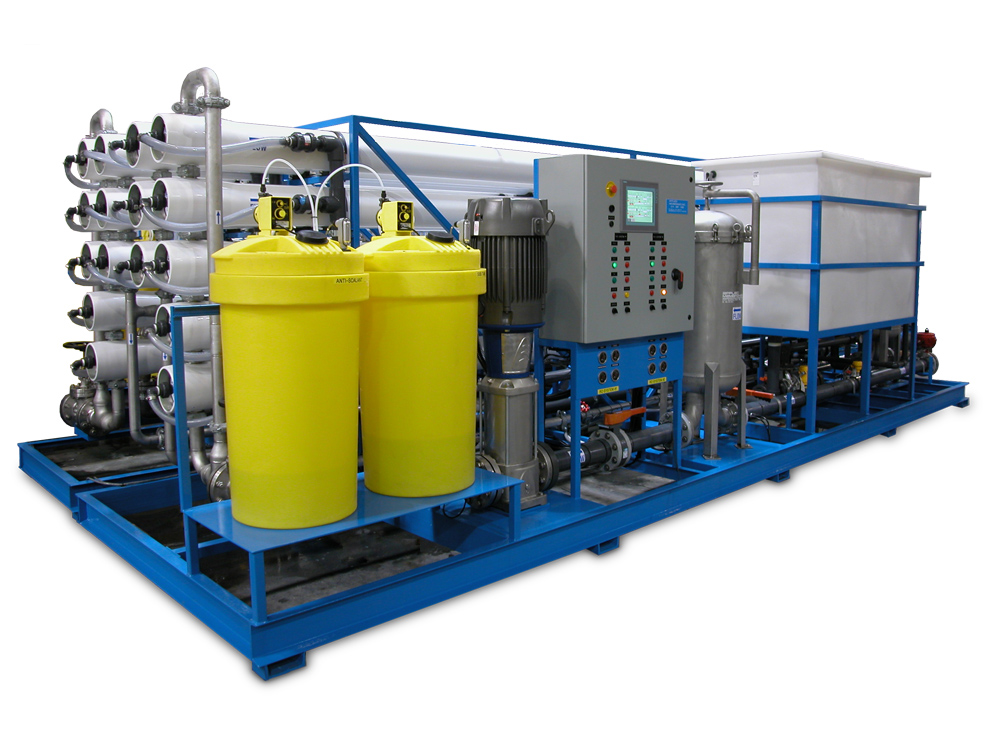PRODUCTS & SERVICES




Membrane Processes Plants
KREYWIN is involved in manufacturing and supplying of a comprehensive range of Reverse Osmosis plants, Ultra-filtration plants, Nano filtration plants, containerized water treatment plants, water purification systems etc.
Among the different membrane separation techniques, pressure-driven processes are simplest in terms of their ability to separate particulates in liquid and gas feed streams according to size. Through utilizing pressure as a driving force for separation, with a membrane acting as a semipermeable barrier, pressure-driven processes are also associated with higher flux compared to their thermal and concentration-based separation counterparts. Types of pressure-driven membrane separation techniques are categorized according to membrane pore size, which, in turn, dictates the degree of separation achieved. These categories are microfiltration (MF), ultrafiltration (UF), nanofiltration (NF), and reverse osmosis (RO).
A) Microfiltration (MF) Plants
Microfiltration (MF) lies on the upper end of the spectrum of pressure-driven membrane techniques, with membranes containing the largest pore size of the aforementioned processes. It is capable of separating suspended solids within the range of 0.1-10μm and is often used as a precursor step to downstream filtration applications in order to achieve the desired degree of separation within a given feed stream. Due to the larger pore size of MF membranes, many of these processes are capable of being run at lower pressures than those with membranes containing smaller pores. Common MF applications involve the separation of large macromolecules in clarification steps, such as in the removal of bacteria from cellular broths and in fat removal processes in the dairy industry.
B) Ultrafiltration (UF) Plants
Within the family of pressure-driven membrane processes, ultrafiltration (UF) lies between microfiltration and nanofiltration in terms of pore size, which can range from 1-100 nm. This size range allows for the concentration of high molecular weight proteins, macromolecules, and other small, suspended solids. In contrast to MF, UF membranes are categorized with respect to their molecular weight cutoff, i.e., their ability to retain a molecule of a given size, rather than by the size of their pores. Nevertheless, the pore size range of UF membranes makes them well-suited for use in a wide variety of ultrafiltration applications across multiple industries. In the automotive industry, UF is used in the recovery of undeposited paint for reuse in the electrocoating process. In the food and beverage industries, it is used in applications ranging from the concentration of whey protein to the clarification of fruit juices.
UF plants are gaining huge popularity as pre-treatment to RO since it saves RO membranes from variety of foulants. Surface water and treated waste water is pre-treated in UF prior to feeding it to RO as it allows RO to do its job of removing dissolved salts effectively. Absence of UF in such cases results in frequent failures, CIP requirements and consequential losses for the end user.
Ultra-filtration plants can be constructed by employing hollow fiber membranes or spiral wound membranes. They work with a pressure of about 1-5 bar and they are suitable to separate higher molecular weight particles present in water. The ultrafiltration plants have established a position in the drinking water sector due to the fact that they filter water to such an extent that it is virtually free of solids. Bacteria, parasites and viruses are not killed off, but entirely removed from the drinking water.
C) Nanofiltration (NF) Plants
In contrast to MF and UF, in which solutes are separated according to size, both size and charge play a role in nanofiltration (NF) separation processes. With a pore size between 0.1-10 nm, NF membranes are capable of retaining low molecular weight, uncharged solutes, such as sugars and other organic molecules. NF membranes also retain charged species, such as polyvalent ions and large monovalent ions, whereas smaller monovalent species pass through. Applications for NF membranes range from the removal of natural organic matter in wastewater treatment, hardness reduction in water purification, and whey demineralization in dairy processing.
Nano filtration plant are generally constructed by installing spiral wound membranes. They have a medium-high working pressure (4-30 bar) and they are normally used to reduce water hardness, to recover salts from dying baths, to remove color and to recover acids and caustic soda. As against RO, the NF membranes remove only multi-valent ions and hence can be used for softening. The operating costs of NF are much lower than RO due to low operating pressure of NF membranes.
D) Reverse Osmosis (RO) Plants
Reverse osmosis (RO) membranes contain the smallest pores of the pressure-driven membrane processes and are capable of retaining all dissolved particles within a feed stream, including monovalent ions. This degree of separation results in a permeate consisting of pure solvent, which, in many cases, is water. Separation using RO is accomplished not only through size exclusion but utilizes a diffusive mechanism as well. The necessity of overcoming the osmotic pressure, in addition to the extremely narrow pore size found in RO membranes, results in RO processes requiring higher pressures than those previously mentioned. The most common applications for RO are in the preparation of drinking water and beverage concentration.
We carefully design the plants taking into consideration various aspects such as source of water, SDI, fouling potential, temperature, desired flux rates for specific applications, scaling potentials, hydraulic balancing, type of membranes, beta factor, LSI, pretreatment, automation etc so that the plants run smoothly for long durations.
Reverse Osmosis plants are quite exclusively constructed by installing spiral wound membranes. They work with medium-high pressure depending on the type of application (6-70 bar) and they are applied to separate the dissolved salts from aqueous solutions by means of semi-permeable membranes. In this case the dimension of membrane pores are very small so that the resistance to the passage of water is higher.
Our core strength is designing an optimum system which can operate smoothly for longer durations. We provide reverse osmosis solutions for
E) Brackish waterF) Sea water desalination
G) Effluent re-cycle
25, Ojo Olagun close, off Bishop Oluwole st,
Victoria Island Lagos Nigeria




